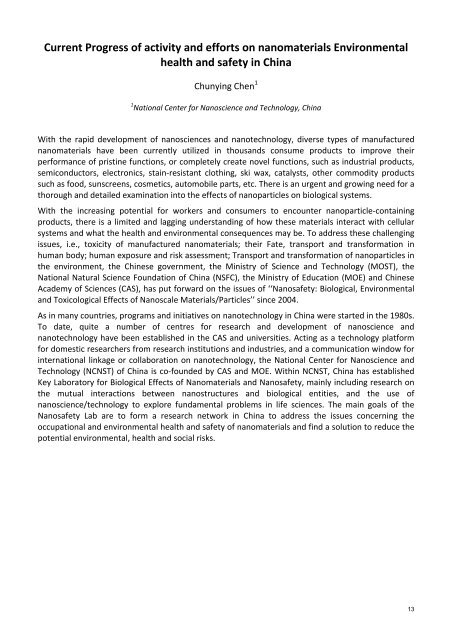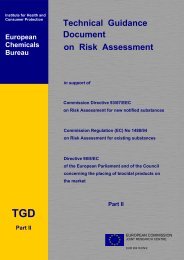Challenges of Regulation and Risk Assessment of Nanomaterials
Challenges of Regulation and Risk Assessment of Nanomaterials
Challenges of Regulation and Risk Assessment of Nanomaterials
Create successful ePaper yourself
Turn your PDF publications into a flip-book with our unique Google optimized e-Paper software.
Current Progress <strong>of</strong> activity <strong>and</strong> efforts on nanomaterials Environmental<br />
health <strong>and</strong> safety in China<br />
Chunying Chen 1<br />
1 National Center for Nanoscience <strong>and</strong> Technology, China<br />
With the rapid development <strong>of</strong> nanosciences <strong>and</strong> nanotechnology, diverse types <strong>of</strong> manufactured<br />
nanomaterials have been currently utilized in thous<strong>and</strong>s consume products to improve their<br />
performance <strong>of</strong> pristine functions, or completely create novel functions, such as industrial products,<br />
semiconductors, electronics, stain-resistant clothing, ski wax, catalysts, other commodity products<br />
such as food, sunscreens, cosmetics, automobile parts, etc. There is an urgent <strong>and</strong> growing need for a<br />
thorough <strong>and</strong> detailed examination into the effects <strong>of</strong> nanoparticles on biological systems.<br />
With the increasing potential for workers <strong>and</strong> consumers to encounter nanoparticle-containing<br />
products, there is a limited <strong>and</strong> lagging underst<strong>and</strong>ing <strong>of</strong> how these materials interact with cellular<br />
systems <strong>and</strong> what the health <strong>and</strong> environmental consequences may be. To address these challenging<br />
issues, i.e., toxicity <strong>of</strong> manufactured nanomaterials; their Fate, transport <strong>and</strong> transformation in<br />
human body; human exposure <strong>and</strong> risk assessment; Transport <strong>and</strong> transformation <strong>of</strong> nanoparticles in<br />
the environment, the Chinese government, the Ministry <strong>of</strong> Science <strong>and</strong> Technology (MOST), the<br />
National Natural Science Foundation <strong>of</strong> China (NSFC), the Ministry <strong>of</strong> Education (MOE) <strong>and</strong> Chinese<br />
Academy <strong>of</strong> Sciences (CAS), has put forward on the issues <strong>of</strong> ‘‘Nanosafety: Biological, Environmental<br />
<strong>and</strong> Toxicological Effects <strong>of</strong> Nanoscale Materials/Particles’’ since 2004.<br />
As in many countries, programs <strong>and</strong> initiatives on nanotechnology in China were started in the 1980s.<br />
To date, quite a number <strong>of</strong> centres for research <strong>and</strong> development <strong>of</strong> nanoscience <strong>and</strong><br />
nanotechnology have been established in the CAS <strong>and</strong> universities. Acting as a technology platform<br />
for domestic researchers from research institutions <strong>and</strong> industries, <strong>and</strong> a communication window for<br />
international linkage or collaboration on nanotechnology, the National Center for Nanoscience <strong>and</strong><br />
Technology (NCNST) <strong>of</strong> China is co-founded by CAS <strong>and</strong> MOE. Within NCNST, China has established<br />
Key Laboratory for Biological Effects <strong>of</strong> <strong>Nanomaterials</strong> <strong>and</strong> Nanosafety, mainly including research on<br />
the mutual interactions between nanostructures <strong>and</strong> biological entities, <strong>and</strong> the use <strong>of</strong><br />
nanoscience/technology to explore fundamental problems in life sciences. The main goals <strong>of</strong> the<br />
Nanosafety Lab are to form a research network in China to address the issues concerning the<br />
occupational <strong>and</strong> environmental health <strong>and</strong> safety <strong>of</strong> nanomaterials <strong>and</strong> find a solution to reduce the<br />
potential environmental, health <strong>and</strong> social risks.<br />
13








